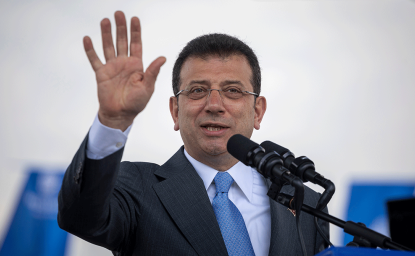The 2011-12 Russian Election Season in Light of Larger Trends

“I want to put into perspective how [the current Russian presidential election] fits into larger trends in Russia’s political system over the last twenty years,” said Henry Hale, Associate Professor of Political Science and International Affairs and Director, Institute for European, Russian and Eurasian Studies, George Washington University, and former Title VIII-Supported Research Scholar, Kennan Institute, at a 30 January 2012 Kennan Institute event. The speaker emphasized that while the current political situation in Russia is unique to the country, it also is reflective of larger patterns that can be found throughout earlier periods of Russian history.
Hale likened the present-day political environment in Russia to a “giant political machine” that traced its origins to infrastructural changes and shifts of power that occurred in the federal government over the last twenty years. Ultimately, the legacy of the Soviet Union lent itself to the emergence of large corporate conglomerates in the Russian Federation and transferred significant power to the executives running them—today’s oligarchs, as it were.
Hale explained that the “great creation” of the modern-day Russian central government incorporates parts of both the presidential system as well as the parliamentary system. Originally, the post-Soviet government concentrated power in the legislature, and the elected president was not originally anticipated to play a dominant role in governing. However, President Boris Yeltsin was keen to retain his power after the transition from Soviet rule—as was the Russian parliament—which resulted in a clash between the two governing bodies. These clashes escalated to Yeltsin’s use of military force against the parliament in October of 1993, whereupon Yeltsin introduced a constitution that granted the president significant political authority over the parliament. According to the speaker, the importance of the president’s role has only increased since Putin came to power.
Additionally, the political regimes on the regional level were also able to gain extensive power and clout after the fall of the Soviet Union. Regional governors were able to “amass a great deal of power over the local economies,” according to Hale, including the power to privatize various economic sectors. However, these regional governments did not initially govern in accordance with the federal legislation: through the end of the 1990s, up to 30 percent of the regions in the Russian Federation adopted laws that directly contradicted federal laws.
The transfer of power from Boris Yeltsin to Vladimir Putin prompted certain infrastructural issues; in particular, the size of the regional networks, the amount of power the regional leaders held, and the lack of coordination between the federal and regional governments posed a potential for political instability within the country. When Vladimir Putin ran for president in 2000, the “corporate conglomerate network” that formed the Fatherland All-Russia coalition ultimately lobbied to stay in favor with the prevailing political power. Aligning politically with the Putin administration was critical for regional and business leaders to retain their influence, especially as Putin’s public support rapidly rose in early 2000. Hale attributed Putin’s surge in popularity to his decisive leadership in response to Chechen terrorist attacks, which ultimately led the Fatherland coalition to distance itself from the opposition movement and throw its support behind Putin. Ultimately, the speaker argued, Putin’s mass popularity would have won him the presidency in 2000, even if the elections were free, fair, and devoid of the support of corporate conglomerates.
Upon being officially elected to power, however, Hale explained that Putin redesigned the political machine to operate to the president’s maximum advantage. Indeed, during his first term, President Putin centralized power in the Kremlin by undercutting the authority of regional governments; presidential envoys were sent to various parts of the Federation in an attempt to provide alternative infrastructures to the existing regional governments. The Kremlin proceeded to centralize power and control over private industries by targeting the leadership of various corporations and government sectors, which ultimately led to the decline of the oligarchs. Hale cited the arrest of Mikhail Khodorkovsky as the most famous example of Putin’s initiative to centralize power within the presidency.
With Putin dominating the leadership of both the public and private sectors in Russia for more than a decade, the president’s announcement to step down from his position in 2007 prompted notable political tension in Russia, noted Hale. While the Russian constitution mandates that presidents can only serve for two terms, Putin’s dominance of the political scene and the United Russia party allowed him de facto to stay in power while giving the presidency to Dmitry Medvedev. Putin’s decision to leave the presidency created a certain level of risk for his position, but his sustained popularity has been part of the reason the current political machine has survived at all, Hale argued. While Putin has had dominance over and support from major sectors of the Russian economy, such as the oil and natural gas industries, he has also maintained a personable relationship with the electorate.
The continued popularity of Vladimir Putin has played a critical role in his political success. However, the 2012 presidential elections may prove that Putin’s reign is coming to a close, Hale explained. Putin’s decrease in popularity in 2011 could be attributed to the decline in the Russian economy, but the speaker suggested that the population also seems tired of Putin; indeed, Putin has held some position of executive power for over a decade. The recent intensification of frustration among those already dissatisfied with Putin, Hale noted, happened when Putin and Medvedev announced that they planned to switch positions again, which was their plan from the start. That detail, Hale argued, sent a message to the electorate that their votes were worthless, and that it was assumed they would just blindly support the United Russia party under any circumstance.
However, regional leaders—the governors Putin and Medvedev appointed throughout his reign—ultimately demonstrated that they didn’t have the political skills needed to generate the votes necessary to rig the December 2011 parliamentary elections in favor of the United Russia party. United Russia essentially campaigned against the governors that the party itself had appointed. Not surprisingly, this strategy ultimately failed for the Kremlin: voters apparently understood that the regional governors were inextricably linked to the United Russia party. The rigging of the parliamentary elections in the regions thus resulted in appearing sloppy and poorly executed, according to Hale. Furthermore, the use of the internet to document and spread information about that blatant election fraud ultimately sparked the recent protests after the parliamentary elections in 2011. “There is a lot of uncertainty left with this presidential election,” Hale concluded, “but I think it will depend a lot on how the Putin regime runs the campaign.”
Blair Ruble, Director, Kennan Institute
Author

Kennan Institute
After more than 50 years as a vital part of the Wilson Center legacy, the Kennan Institute has become an independent think tank. You can find the current website for the Kennan Institute at kennaninstitute.org. Please look for future announcements about partnership activities between the Wilson Center and the Kennan Institute at Wilson Center Press Room. The Kennan Institute is the premier US center for advanced research on Eurasia and the oldest and largest regional program at the Woodrow Wilson International Center for Scholars. The Kennan Institute is committed to improving American understanding of Russia, Ukraine, Central Asia, the South Caucasus, and the surrounding region through research and exchange. Read more

Explore More
Browse Insights & Analysis
Greenland’s New Governing Coalition Signals Consensus

Myanmar’s Junta and the 2026 Elections: A Fig Leaf for Legitimacy?

